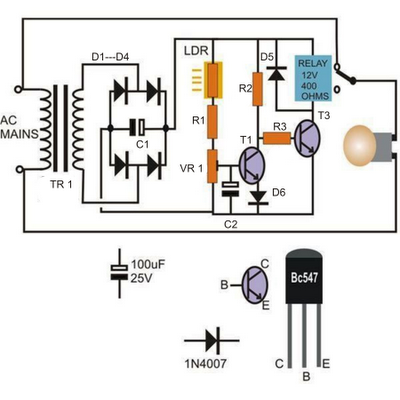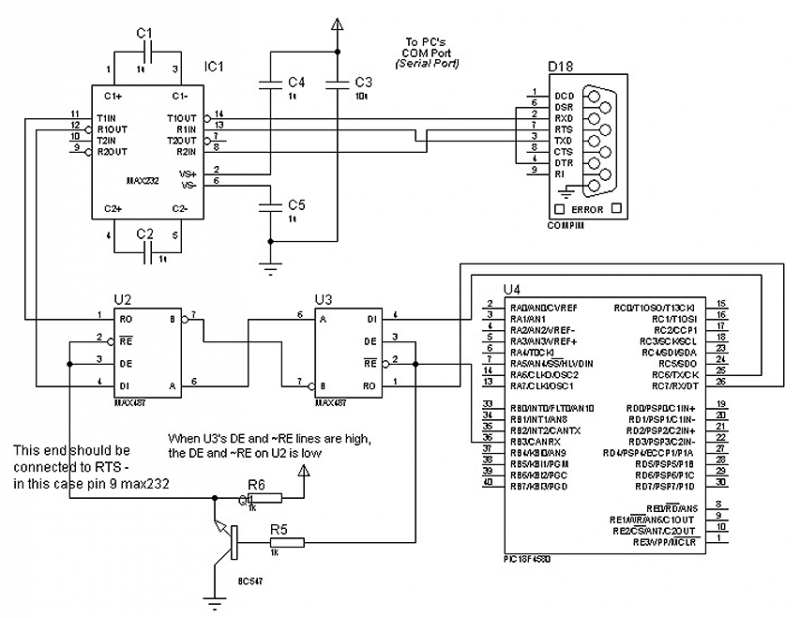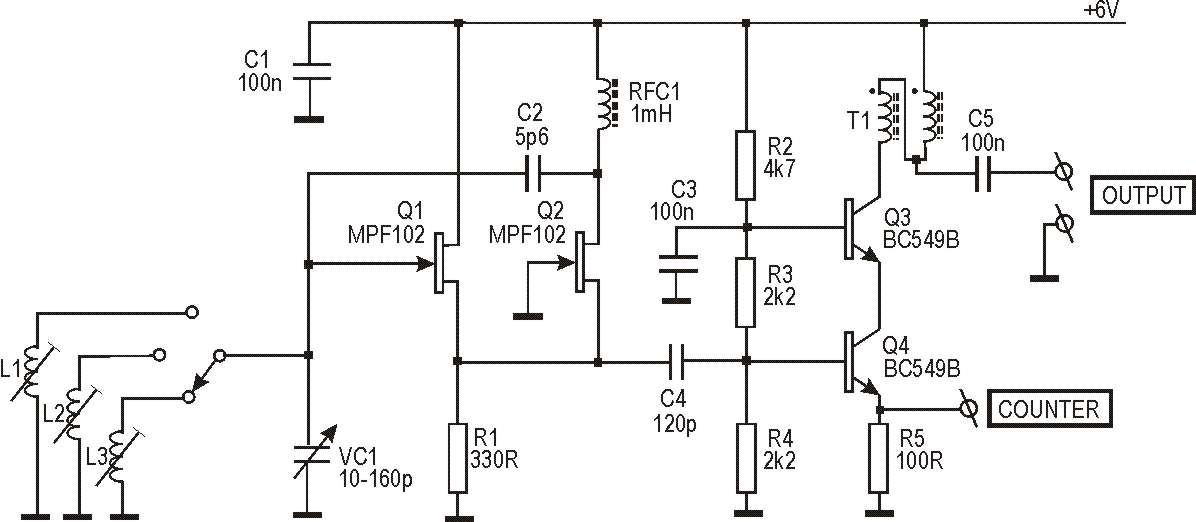
simple automatic street light system

The left-hand side transistor T1 is configured as a voltage comparator utilizing a resistive network. The resistor in the upper arm is a light-dependent resistor (LDR), while the lower arm resistor is a preset resistor used to establish threshold values. T2 is set up as an inverter, inverting the signal received from T1. Initially, when the light level is low, the LDR maintains a high resistance, preventing sufficient current from reaching the base of transistor T1. This condition allows the collector potential of T2 to saturate, keeping the relay activated. As the light level increases, the resistance of the LDR decreases, allowing more current to flow through to the base of T1. Consequently, T1 conducts, pulling its collector potential to ground, which inhibits T2's conduction, turning off the relay and the connected lamp. The entire circuit can be constructed on a small piece of vero board and housed in a sturdy plastic enclosure. The LDR should be positioned outside the enclosure, with its sensing surface exposed to the ambient light that needs to be monitored.
The circuit operates based on the principle of light intensity detection through the voltage comparison between the LDR and the preset resistor. The LDR's resistance varies inversely with the light intensity; as light increases, its resistance decreases, allowing more current to flow through the circuit. The preset resistor serves to adjust the sensitivity of the circuit, enabling it to respond to specific light levels based on the application requirements.
Transistor T1 functions as a key component in determining whether the light level exceeds the preset threshold. When the voltage at the base of T1, influenced by the LDR, surpasses the set threshold defined by the preset resistor, T1 transitions from cutoff to saturation. This transition effectively alters the state of transistor T2, which is configured as an inverter. The output of T2, therefore, directly controls the relay, which in turn controls the power to the connected lamp.
The relay acts as a switch, allowing or interrupting the flow of current to the lamp based on the output state of T2. When T1 is in saturation, T2 is turned off, deactivating the relay and thus the lamp. Conversely, when the light level is low, T1 remains off, allowing T2 to remain on and the relay to activate the lamp. This creates a simple yet effective light-activated switch.
For practical implementation, the entire circuit is compactly designed to fit on a vero board, which simplifies the assembly and reduces the need for complex printed circuit boards. The choice of a sturdy plastic box for housing the circuit ensures durability and protection from environmental factors. Special attention should be given to the placement of the LDR to ensure accurate light sensing, as it must be positioned in an area where it can receive unobstructed light. This design is ideal for applications such as automatic lighting systems, where the lamp should turn on or off based on ambient light conditions.The left hand side transistor T1 is rigged as a voltage comparator using a resistive network. The resistor at the upper arm is the LDR and the lower arm resistor is the preset which is used to set the threshold values or levels. T2 is arranged as an inverter, and inverts the response received from T1. Initially, assuming the light level is less, t he LDR sustains a high resistance level across it, which does not allow enough current to reach the base of the transistor T1. This allows the potential level at the collector to saturate T2 and consequently the relay remains activated in this condition.
When the light level increases and becomes sufficiently large on the LDR, its resistance level falls, this allows more current to pass through it which eventually reaches the base of T1. The transistor T1 conducts, pulling its collector potential to ground. This inhibits the conduction of the transistor T2, switching OFF its collector load relay and the connected lamp.
The whole circuit can be built over a small piece of vero board and the entire assembly along with the power supply may be housed inside a sturdy little plastic box. The LDR must be placed outside the box, meaning its sensing surface should be exposed toward the ambient area from where the light level is required to be sensed.
🔗 External reference
The circuit operates based on the principle of light intensity detection through the voltage comparison between the LDR and the preset resistor. The LDR's resistance varies inversely with the light intensity; as light increases, its resistance decreases, allowing more current to flow through the circuit. The preset resistor serves to adjust the sensitivity of the circuit, enabling it to respond to specific light levels based on the application requirements.
Transistor T1 functions as a key component in determining whether the light level exceeds the preset threshold. When the voltage at the base of T1, influenced by the LDR, surpasses the set threshold defined by the preset resistor, T1 transitions from cutoff to saturation. This transition effectively alters the state of transistor T2, which is configured as an inverter. The output of T2, therefore, directly controls the relay, which in turn controls the power to the connected lamp.
The relay acts as a switch, allowing or interrupting the flow of current to the lamp based on the output state of T2. When T1 is in saturation, T2 is turned off, deactivating the relay and thus the lamp. Conversely, when the light level is low, T1 remains off, allowing T2 to remain on and the relay to activate the lamp. This creates a simple yet effective light-activated switch.
For practical implementation, the entire circuit is compactly designed to fit on a vero board, which simplifies the assembly and reduces the need for complex printed circuit boards. The choice of a sturdy plastic box for housing the circuit ensures durability and protection from environmental factors. Special attention should be given to the placement of the LDR to ensure accurate light sensing, as it must be positioned in an area where it can receive unobstructed light. This design is ideal for applications such as automatic lighting systems, where the lamp should turn on or off based on ambient light conditions.The left hand side transistor T1 is rigged as a voltage comparator using a resistive network. The resistor at the upper arm is the LDR and the lower arm resistor is the preset which is used to set the threshold values or levels. T2 is arranged as an inverter, and inverts the response received from T1. Initially, assuming the light level is less, t he LDR sustains a high resistance level across it, which does not allow enough current to reach the base of the transistor T1. This allows the potential level at the collector to saturate T2 and consequently the relay remains activated in this condition.
When the light level increases and becomes sufficiently large on the LDR, its resistance level falls, this allows more current to pass through it which eventually reaches the base of T1. The transistor T1 conducts, pulling its collector potential to ground. This inhibits the conduction of the transistor T2, switching OFF its collector load relay and the connected lamp.
The whole circuit can be built over a small piece of vero board and the entire assembly along with the power supply may be housed inside a sturdy little plastic box. The LDR must be placed outside the box, meaning its sensing surface should be exposed toward the ambient area from where the light level is required to be sensed.
🔗 External reference





